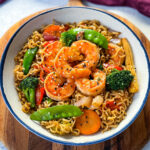This Shrimp Stir Fry With Noodles recipe is a quick and easy recipe with succulent shrimp, crisp veggies, and perfectly cooked noodles tossed in a savory sauce. This dish is perfect for busy weeknights or when you need to switch up your routine with an easy meal.

This post contains affiliate links. Please read my full disclosure here.
Key Ingredients
- Noodles
- Shrimp
- Vegetables
- Olive Oil
- Ginger
- Soy Sauce
- Rice Vinegar
- Brown Sugar or Sweetener
- Cornstarch
- Spices

What Type of Shrimp to Use
Here are some considerations and things to look for:
- Freshness: Look for shrimp with a firm texture, a pleasant ocean-like smell, and no signs of discoloration or sliminess.
- Size: Larger shrimp are often preferred for stir fry meals, as they have a meatier texture and can hold up well to the gentle cooking process. Medium to jumbo shrimp sizes work well. Check out our Shrimp Size Guide and Counts Per Pound for more information on what count to buy.
- Shell-On or Peeled: You can buy shell-on or peeled shrimp. Just keep in mind you will have to remove them.
- Deveined Shrimp: Deveined shrimp are convenient and will save you time since you won’t have to devein the shrimp yourself. This refers to the process of removing the digestive tract or “vein” that runs along the back of a shrimp. To devein a shrimp, you’ll need to make a shallow incision along the back of the shrimp, exposing the vein. You can then use a small knife or a deveining tool to gently lift and remove the vein.
- Wild-Caught or Farm-Raised: Wild-caught shrimp refers to shrimp that are harvested directly from their natural habitat, such as oceans, seas, or rivers, rather than being raised in aquaculture (fish farming) facilities. Decide which type you prefer.
What Vegetables to Use
I like to use Trader Joe’s Asian Vegetable Stir fry. It’s affordable and saves me a lot of time without the need to slice and dice vegetables. The key is to balance a variety of textures and flavors. Feel free to mix and match these vegetables based on your personal preferences.
You can also use whatever leftover veggies you have in the fridge that will go bad soon or experiment with other seasonal or favorite veggies you have on hand.
Here are some options and substitutions:
- Bell Peppers: Add vibrant colors and a sweet crunch to your stir fry. Use a mix of red, green, and yellow peppers if you want to make it colorful.
- Broccoli: Broccoli florets bring a hearty and slightly earthy flavor. Make sure to cut them into bite-sized pieces for even cooking.
- Snap Peas or Snow Peas: These add a delightful crunch and a touch of sweetness. They require minimal cooking time to retain their crisp texture.
- Carrots: These are great for a satisfying crunch and a pop of color and natural sweetness.
- Mushrooms: Sliced mushrooms, such as shiitake or button mushrooms, contribute a savory, umami flavor to the stir fry.
- Zucchini or Yellow Squash: Slice them into thin rounds or cubes to bring a mild, refreshing taste and a softer texture to the dish.
- Water Chestnuts: For a crisp and slightly nutty texture, consider adding sliced water chestnuts. They stay crunchy even after cooking.
- Cabbage: Shredded cabbage adds a sweet and mild flavor, as well as a pleasant crunch. It cooks quickly, making it an easy addition.
- Baby Corn: These miniature corn cobs offer a unique texture and a subtly sweet flavor.
- Bean Sprouts: Sprinkle fresh bean sprouts over the finished stir fry to add a refreshing and crunchy element.
- Scallions (Green Onions): Finely sliced scallions can be added at the end for a burst of freshness and a mild onion flavor.
Frozen Vegetables vs Fresh
You can use frozen vegetables but do so with caution. I have not had the best luck using frozen stir-fry vegetables that come packaged with a variety of veggies. The end result was always soggy for me. It could be the brand I used, so this may not be an issue for you. I’m simply sharing my experience.
Here are some additional considerations.
- Thawing: If using larger frozen vegetables like broccoli or mixed stir-fry vegetables, it’s a good idea to thaw them before cooking. You can do this by placing them in the refrigerator for a few hours.
- Timing: Keep in mind that frozen vegetables will release some moisture during cooking, affecting the overall texture of the stir fry. Adjust the cooking time accordingly and drain any excess liquid as needed.

What Type of Noodles to Use
I like to use instant ramen noodles can be used as a quick and easy option. Discard the seasoning packet and cook the noodles separately before adding them to the stir fry. Here are more options:
- Rice Noodles: Rice noodles, such as vermicelli or flat rice noodles, are a common choice. They have a light and delicate texture and absorb flavors well.
- Udon Noodles: Thick and chewy udon noodles add a hearty and satisfying element. They are great for absorbing the savory sauces.
- Soba Noodles: Made from buckwheat flour, soba noodles have a nutty flavor and a slightly chewy texture. They can add a unique twist.
- Egg Noodles: Chinese-style egg noodles or even wide rice noodles provide a soft and silky texture.
- Lo Mein Noodles: They have a chewy texture and absorb flavors well.

Flavor and Seasoning
I use a combination of fresh ginger (ground ginger works), soy sauce or liquid aminos, rice vinegar, brown sugar or sweetener, and garlic. Here are other things you can use if you want:
- Oyster Sauce
- Sesame Oil
- Chili Sauce
- Fresh herbs like cilantro, green onions, and basil
- Hoisin Sauce
- Fish Sauce
I have not tested the recipe adding any of the ingredients. If you choose to use them, add enough to suit your taste.
How to Make Shrimp Stir Fry with Noodles
Detailed measurements and full instructions can be found in the recipe card at the bottom of this post.
- Season both sides of the shrimp with smoked paprika, onion powder, salt, and pepper to taste.
- Heat a skillet on medium-high heat with olive oil. When hot, add the shrimp.
- Cook and remove the shrimp from the pan and set it aside.
- Add vegetables, garlic, and ginger to the pan and cook. Remove the vegetables and set aside.
- Add soy sauce, rice vinegar, and brown sugar or sweetener to the pan at medium heat. Stir until the sweetener has fully dissolved.
- Combine the cornstarch and cold water separately in a bowl. Make sure the mixture is smooth and fully incorporated. Then add it to the sauce ingredients and stir. Stir for a few minutes until the sauce thickens.
- Add the cooked shrimp, vegetables, and noodles to the pan. Stir and cook.

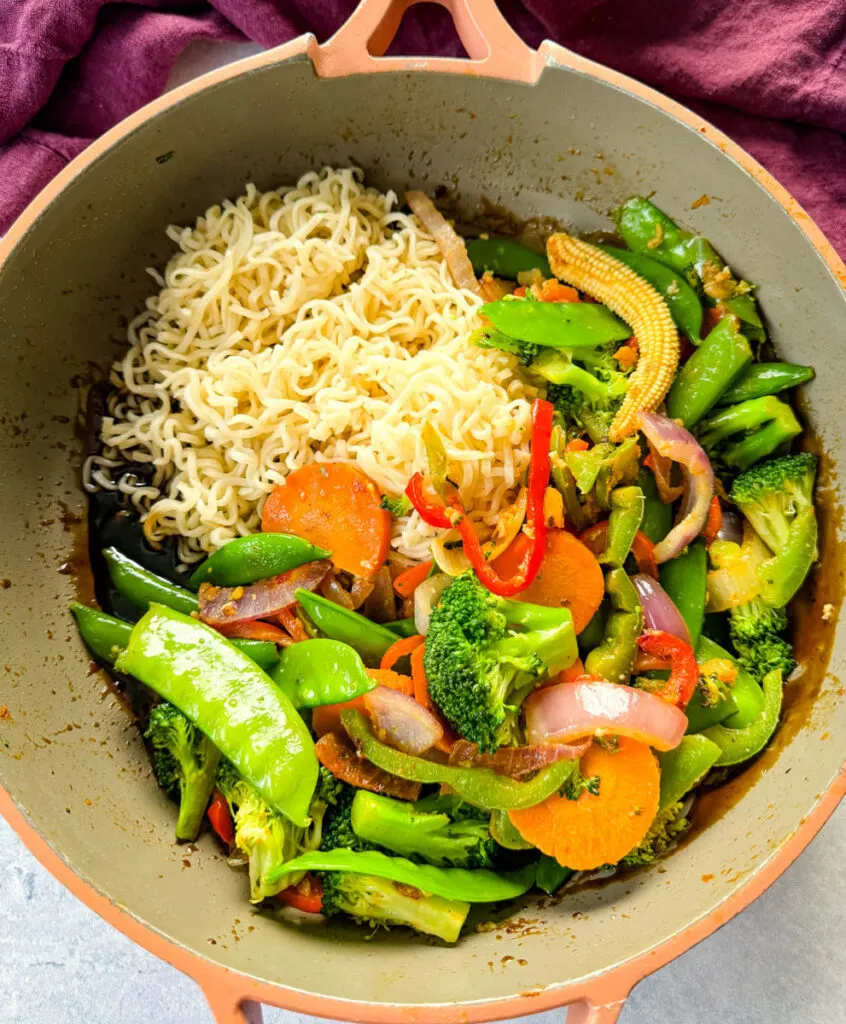
How to Thicken the Sauce
A cornstarch slurry will thicken the sauce. The recipe calls for 1/2 tablespoon of cornstarch and 1/2 tablespoon of cold water. Mix these two together, separately in a bowl. Make sure the mixture is smooth and fully incorporated. Then add it to the sauce ingredients and stir.
Cornstarch tends to settle quickly, especially if not mixed thoroughly. If you add cornstarch to hot liquid without creating a smooth slurry first, it will form lumps. Adding cornstarch directly to hot liquid can cause it to clump because the starch granules seize up when they come into contact with heat. This is why it is important to use cold water.
Do not use old, expired cornstarch. Cornstarch has a shelf life, and if it’s old or has been exposed to moisture, it will clump more easily.
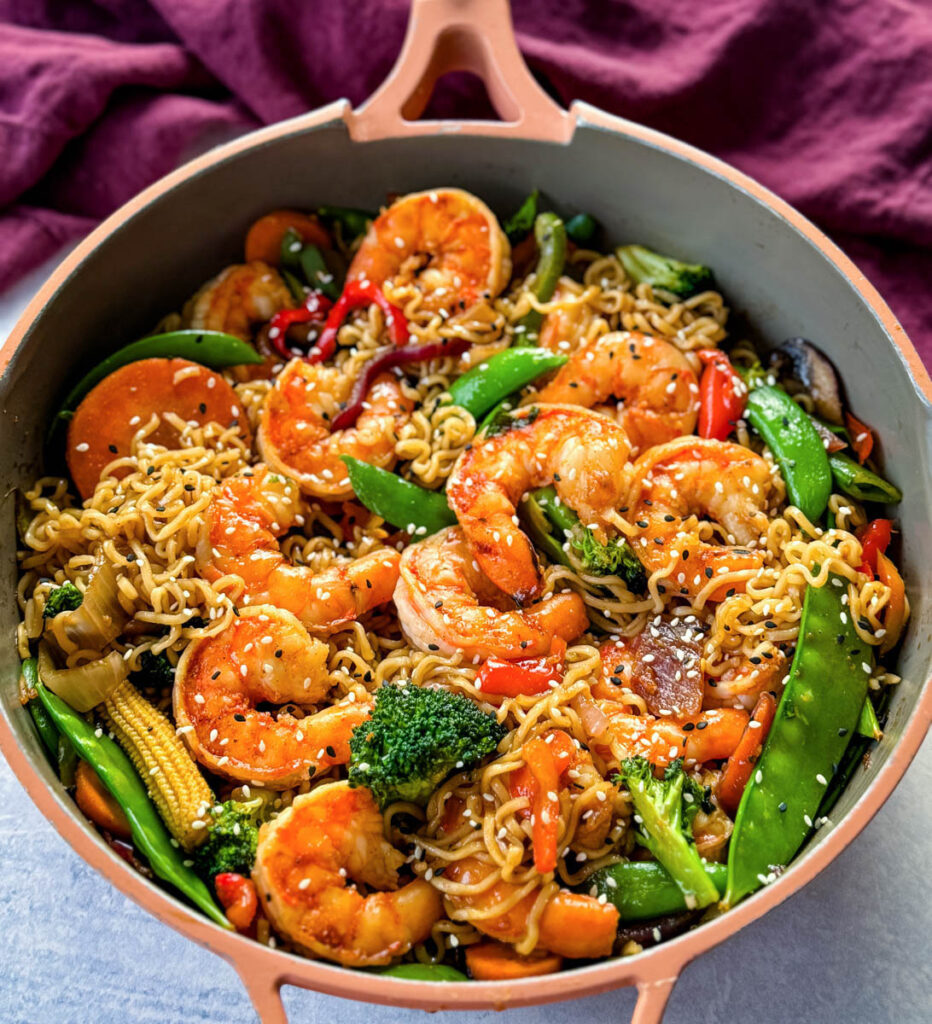
How to Make it Spicy
You can make it spicy by adding Sriracha, sweet chili sauce, or even hot sauce.
What Type of Pan to Use
It’s ideal to use a pan or wok that provides even heat distribution and has enough space for the ingredients to cook quickly and evenly.
Stir-Fry Pan or Skillet: A flat-bottomed stir-fry pan or skillet is a more versatile option that works well on various stovetops, including electric and flat surfaces. It has a wide cooking surface, which is beneficial for stir-frying without overcrowding the pan. Look for a pan with sloping sides to facilitate easy stirring and tossing of ingredients.
Wok: A wok is a traditional choice for stir-frying due to its shape and design. It has high, sloping sides that allow for easy tossing and flipping of ingredients. The wide surface area at the bottom ensures that heat is distributed evenly, allowing for quick cooking. Carbon steel or cast iron woks are commonly used and can withstand high heat. Make sure the wok is well oiled to prevent sticking.
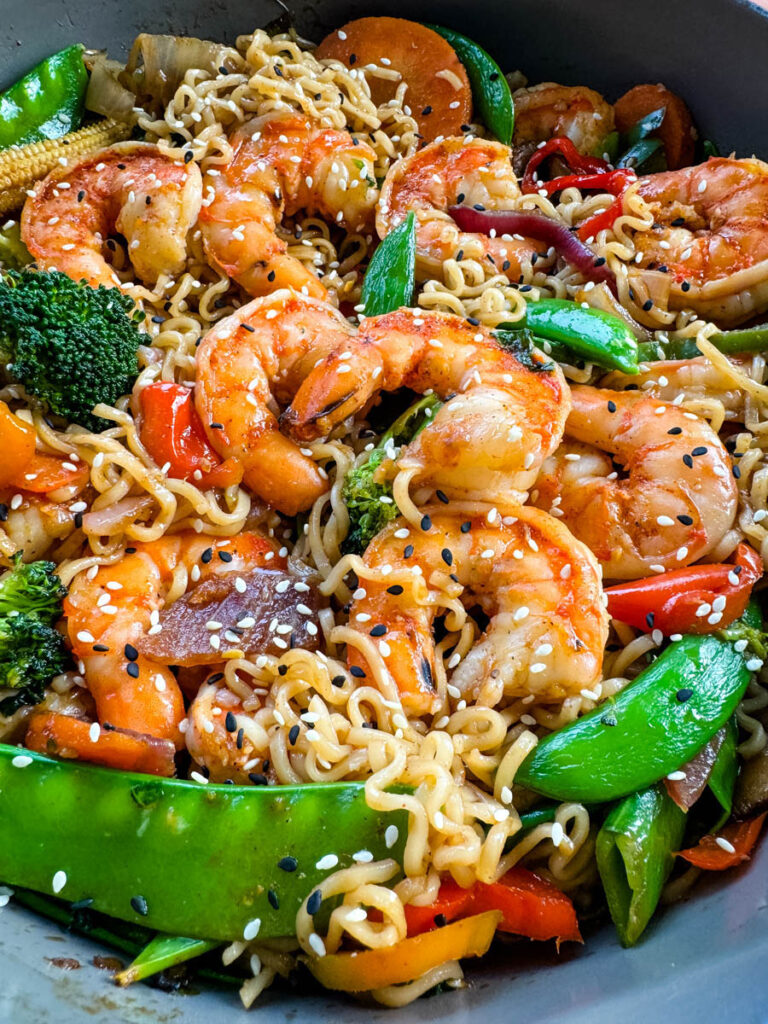
How to Store Leftovers
I recommend separating the noodles from the other ingredients before storing. If you know you will have leftovers, consider this, and don’t add all of the noodles to the pot while cooking.
This helps prevent the noodles from becoming too soggy as they absorb moisture from the sauce and vegetables.
Choose a container that provides an airtight seal to keep the shrimp stir fry fresh. If using a plastic bag, remove as much air as possible before sealing.
Leftovers can be stored tightly covered and sealed for 3-4 days.
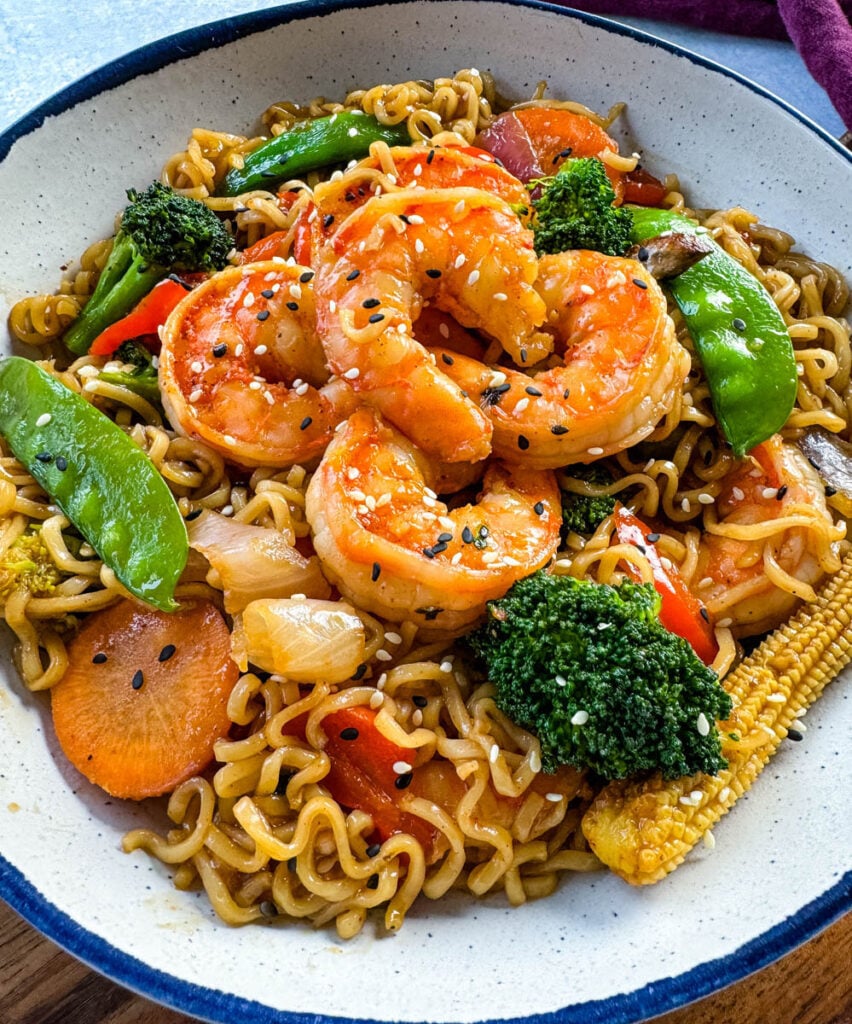
How to Reheat
Reheating on the stove at medium heat works best and won’t compromise the quality of the original texture.
If using the microwave, use medium heat in 1-minute intervals, stirring between each interval. Be careful not to overheat as this will result in a mushy texture.
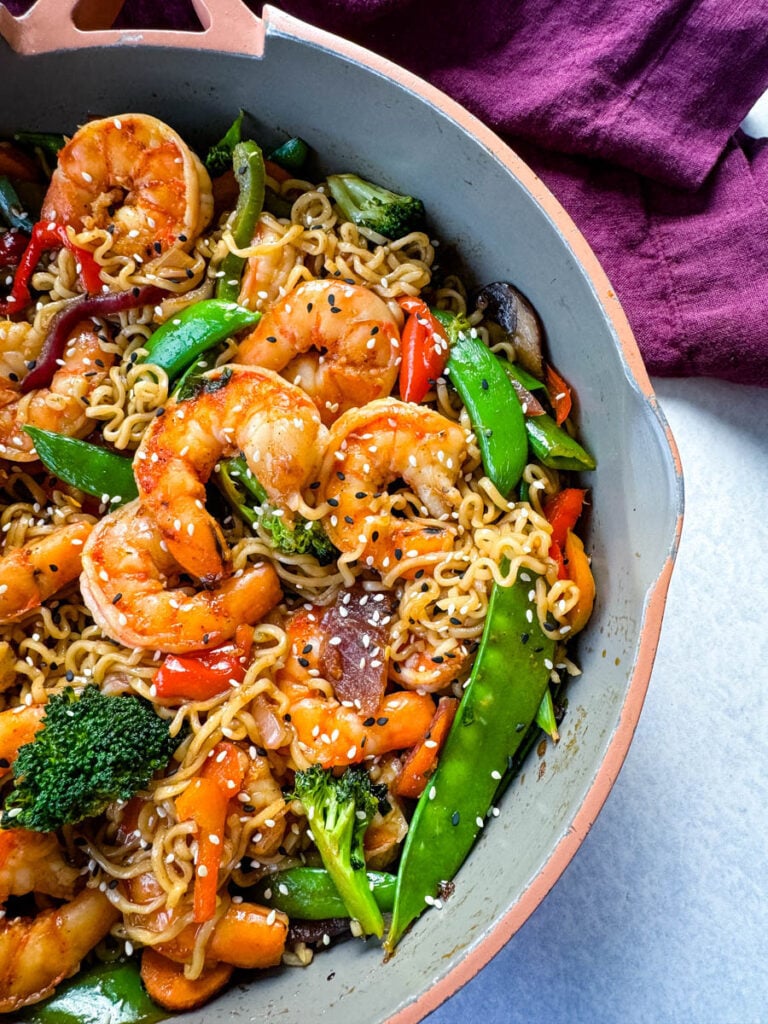
More Shrimp Recipes
Shrimp Burger
Creamy Shrimp and Corn Chowder with Potatoes
Shrimp Taco Salad
Shrimp Spaghetti
Old Bay Steamed Shrimp
Watch step by step instructions on how to make this recipe here on Youtube.
Shrimp Stir Fry with Noodles
Ingredients
- 6-9 oz cooked noodles I used 6oz of ramen. See notes.
- 1- 1 1/2 pounds raw shrimp Peeled and deveined.
- 1/2 teaspoon smoked paprika
- 1/2 teaspoon onion powder
- salt and pepper to taste
- 1 teaspoon olive oil
- 3 cups fresh or frozen mixed vegetables
- 3 garlic cloves Minced.
- 1-2 teaspoons fresh minced ginger Start with 1 teaspoon and adjust to taste. If using ground ginger start with 1/4 teaspoon.
Stir Fry Sauce
- 1/2 cup soy sauce or liquid aminos
- 2 tablespoons rice vinegar
- ¼ cup brown sugar or sweetener Adjust to suit your taste.
- 1/2 tablespoon cornstarch
- 1/2 tablespoon cold water
Instructions
- Season both sides of the shrimp with the smoked paprika, onion powder, salt, and pepper to taste.
- Heat a skillet on medium-high heat with olive oil. When hot, add the shrimp.
- Cook for 2-4 minutes, flipping halfway through until the shrimp turns bright pink and is translucent. Remove the shrimp from the pan and set it aside.
- Add additional olive oil to the pan if necessary. Add the vegetables, garlic, and ginger to the pan and cook for 3-4 minutes until soft. Remove the vegetables and set aside.
- Add the soy sauce, rice vinegar, and brown sugar or sweetener to the pan at medium heat. Stir until the sweetener has fully dissolved.
- Combine the cornstarch and cold water separately in a bowl. Make sure the mixture is smooth and fully incorporated. Then add it to the sauce ingredients and stir. Stir for a few minutes until the sauce thickens.
- Add the cooked shrimp, vegetables, and noodles to the pan. Stir and cook for 2-3 minutes until the sauce is incorporated.

